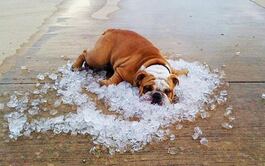 Instead of sweating, dogs eliminate heat by panting. They do have some sweat glands in the footpads, which help with heat dissipation, but only minimally. When panting isn’t enough, a dog’s body temperature rises. This can be fatal if not corrected quickly. Physical Symptoms of Heatstroke in Dogs Excessive panting and signs of discomfort indicate overheating in dogs. A dog overheating may also be unable or unwilling to move around. Other signs of heatstroke in dogs include drooling, reddened gums, vomiting, diarrhea, mental dullness or loss of consciousness, uncoordinated movement, and collapse. Primary Cause of Heatstroke in Dogs Any hot environment can cause heatstroke in dogs, but the most common cause is a careless action by a pet owner, such as leaving a dog in a car or forgetting to provide water and shade to pets that are outdoors. Some dogs are more prone to developing heat exhaustion, especially dogs who are older, overweight or brachycephalic (Pugs, Bulldogs and other flat-faced breeds). It is important to be aware of the ambient temperature and take appropriate preventative measures. Dogs with thick fur, short noses or those suffering from medical conditions such as laryngeal paralysis and obesity are predisposed to heatstroke. Even dogs who enjoy constant exercise and playtime—like working dogs such as Labrador Retrievers and German Shepherds—should be closely monitored for symptoms of heatstroke in dogs, especially on hot days. Immediate CareIt is essential to remove the dog from the hot environment immediately. Do not give the dog aspirin to lower its temperature; this can lead to other problems. If the dog is unconscious, make sure no water enters the nose or mouth as you follow these steps.
Preventing Heatstroke in DogsHeatstroke in dogs can be prevented by taking caution not to expose a dog to hot and humid conditions. This is especially applicable for dogs with airway diseases and breeds with shortened faces. While traveling in cars, make sure that dogs are kept in dog crates that offer good ventilation, or use a dog seat belt, and never leave your dog in a car with the windows closed, even if the car is parked in the shade. When outdoors, always make sure your dog is in a well-ventilated area with access to plenty of water and shady spots.
0 Comments
Leave a Reply. |
Archives
July 2024
Categories |

 RSS Feed
RSS Feed